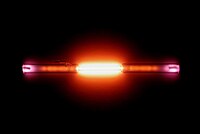
Photo from wikipedia
Abstract Oxide anodes composed of 60 wt% Gd0.1Ce0.8Ni0.1O2 (GDCN)- 40 wt% (Sr0.9La0.1)0.9Ti0.9Ni0.1O3 (SLTN) composites were prepared and tested on (ZrO2)0.89(Sc2O3)0.1(CeO2)0.01 (SSZ) electrolyte-supported SOFC cells utilizing a (La0.75Sr0.25)0.98MnO3 (LSM)-SSZ cathode, in 3%-humidified hydrogen… Click to show full abstract
Abstract Oxide anodes composed of 60 wt% Gd0.1Ce0.8Ni0.1O2 (GDCN)- 40 wt% (Sr0.9La0.1)0.9Ti0.9Ni0.1O3 (SLTN) composites were prepared and tested on (ZrO2)0.89(Sc2O3)0.1(CeO2)0.01 (SSZ) electrolyte-supported SOFC cells utilizing a (La0.75Sr0.25)0.98MnO3 (LSM)-SSZ cathode, in 3%-humidified hydrogen fuel at 800 °C. Improved electrochemical performance was found compared to the cell using Ni-free 60 wt% Gd0.1Ce0.9O2 (GDC) - 40 wt % Sr0.9La0.1TiO3 (SLT) that was attributed to the exsolution of nano-sized Ni particles from the Ni-doped system. This exsolution process represents a simpler, more attractive method to improve performance than the more conventional but more complicated infiltration method for introducing catalytic nanoparticles. Redox cycling testing was performed to investigate the performance and structural stability of the Ni-doped GDC-SLT anode. The results indicated that the Ni exsolution and aggregation occurred while redox cycling proceeded, resulting in a gradually reduced anodic overvoltage. Symmetric cells with dense thin film Gd0.1Ce0.9-xNixO2 (x = 0, 0.05, 0.1, 0.15) electrodes were also tested, demonstrating lower area-specific resistances with increasing Ni content on the surface under reducing conditions. The steady improvement during redox cycling, despite Ni agglomeration, is related to the continuous increase in the overall Ni content on the anode surface, which may be enabled by kinetic limitations to Ni re-dissolving under oxidizing transients.
Journal Title: Journal of Power Sources
Year Published: 2017
Link to full text (if available)
Share on Social Media: Sign Up to like & get
recommendations!